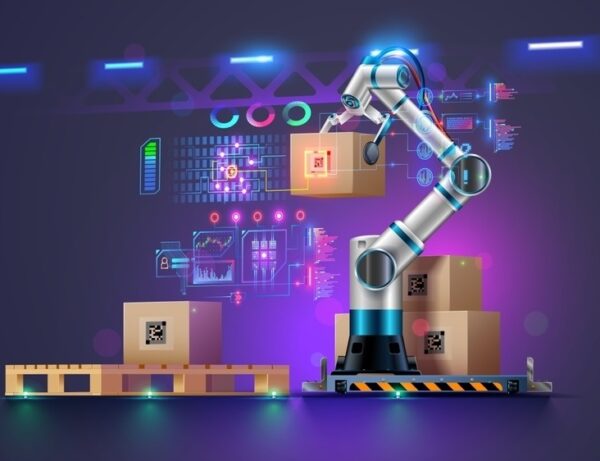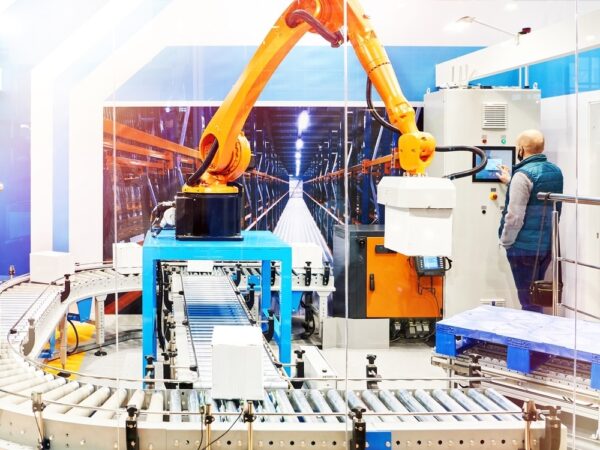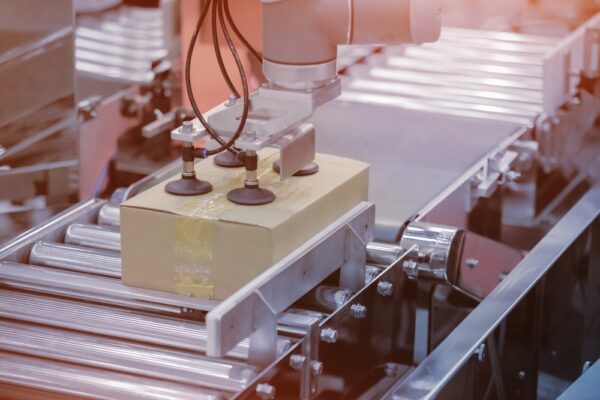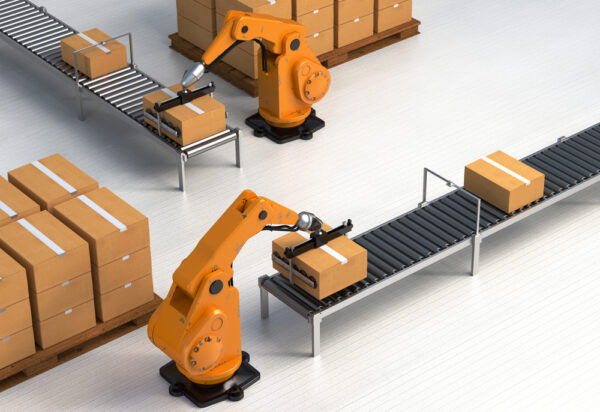
With one robot now present for every 71 humans in global manufacturing, the integration of robotics is reshaping the workforce. Palletizing and packaging, essential steps in manufacturing, are at the forefront of this automation wave. Traditionally labor-intensive, these tasks often lead to bottlenecks, ergonomic concerns, and inconsistencies. The rise of packaging and palletizing robots offers manufacturers a powerful solution to optimize operations and stay ahead in this rapidly evolving landscape.
Palletizing and Packaging: A Common Denominator in Manufacturing
A unique aspect of palletizing and packaging, compared to other machine types like machine tending or pick and place, is its consistent presence in every manufacturing line. Regardless of the product’s shape or size, the end goal of palletizing and packaging remains the same: to take the product off the assembly line, place it in a box (usually quadrilateral), and palletize it.
This uniformity in process and goal, even across diverse industries and product types, simplifies the automation approach compared to the diverse solutions required for other manufacturing processes.
Challenges in Traditional Palletizing and Packaging
Manual palletizing and packaging present numerous challenges:
- Labor Shortages: Finding and retaining skilled labor for repetitive tasks is increasingly difficult.
- Ergonomic Concerns: Repetitive lifting and bending can lead to musculoskeletal injuries.
- Inefficiency: Manual processes are often slower and less consistent than automated ones.
- Quality Control Issues: Human error can result in damaged products or unstable pallets.
The Rise of Packaging and Palletizing Robots
The growing use of packaging and palletizing robots is transforming how manufacturers approach these tasks. By automating repetitive and physically demanding processes, these robots address the challenges of traditional methods, leading to improved workplace safety, increased efficiency, and reduced costs.
A fully automatic robotic palletizing system can seamlessly integrate with existing production lines, handling a wide range of product types and sizes. These robots can work tirelessly around the clock if needed while optimizing palletizing patterns to maximize load stability and space utilization.
In this guide, we’ll explore the numerous benefits of robotic palletizing and packaging, help you choose the right robot for your specific needs, and look into the best practices for optimizing your packaging line.
Whether you’re new to automation and are choosing your first factory automation project or looking to replace an old machine, we hope to provide you with valuable insights to help you make informed decisions and maximize the efficiency of your manufacturing operations.
Related Reading: Arguments That Shouldn’t Hold You Back from Automating Your Manufacturing
Choosing the Right Palletizing and Packaging Robot: A Step-by-Step Guide

Selecting the optimal palletizing robot or packaging robot is crucial for maximizing the benefits of automation in your manufacturing facility. This step-by-step guide will walk you through the key considerations to ensure you choose the perfect robotic solution for your unique needs.
Step 1: DIY Automation Assessment: Is a Robotic Solution Right for You?
Before investing in a palletizing robot or packaging robot, it’s crucial to assess whether robotic automation aligns with your specific needs and goals. A self-assessment will help you determine if a robotic solution is the right fit for your manufacturing operations. You can get more of a detailed breakdown of the automation assessment process in our free downloadable eBook, Automate to Elevate: Your Automation Assessment Guide.
Identifying Bottlenecks and Pain Points in Your Palletizing and Packaging Process
The first step in the assessment is to thoroughly analyze your current palletizing and packaging process.
- Pinpoint Inefficiencies: Identify areas where your current processes are slow, error-prone, or labor-intensive. Look for bottlenecks that hinder your overall productivity.
- Consider Costs: Evaluate the costs associated with your current methods, including labor, materials, and any losses due to errors or damage.
- Assess Throughput: Determine if your current throughput meets your production goals. If not, identify where the limitations lie.
By identifying these pain points, you’ll get a clear understanding of where robotic automation can offer the most significant improvements. You can use our Opportunity Analysis tool to find areas where automated palletizing or other packaging and palletizing robots could bring significant improvements to your operations.
Calculating Potential ROI for Automated Palletizing
Once you’ve identified areas for improvement, it’s time to estimate the potential return on investment (ROI) of implementing a robot palletizer or other packaging and palletizing robots.
- Estimate Cost Savings: Calculate the potential savings in labor costs, material costs, and reduced product damage that automation can bring.
- Factor in Investment Costs: Consider the initial cost of the robotic system, integration expenses, and ongoing maintenance costs.
- Use ROI Calculators: Use an online ROI calculator or consult with automation experts like DEVELOP to assess the financial viability of your investment.
- Scatterplot: Use the scatterplot tool to prioritize the opportunities that align best with your business goals, growth objectives, and risk tolerance.
A thorough ROI analysis will help you determine whether the long-term benefits of automation outweigh the initial investment. However, it’s important to note that focusing solely on ROI can sometimes overlook other valuable benefits.
It’s worth being aware that using an Opportunity Automation Integration (OAI) approach can often achieve the same revenue goals as an ROI-focused strategy. OAI considers a wider range of factors, including scalability, consistency, and employee satisfaction. This broader approach may lead to better long-term outcomes for your business.
Long-Term Vision and Scalability of Your Robotic Palletizing System
Finally, consider your long-term vision and scalability needs.
- Future Production Goals: Think about your future production targets and how your operations might need to evolve.
- Scalable Solutions: Choose a robotic palletizing system or packaging robot that can scale with your business, accommodating increased production volumes or changes in product lines.
- Flexibility: Opt for a system that can adapt to different palletizing patterns and product types, ensuring it remains valuable as your needs change.
By aligning your automation choices with your long-term vision, you’ll ensure that your investment continues to deliver value as your business grows.
Free Download: The Transformative Impact of Automation for Manufacturers
Step 2: Assessing Your Needs
If you’re considering a company investment in packaging and palletizing robots, it’s essential to thoroughly assess your specific requirements. You know you need automation in your facility, and the temptation to Just buy a robot is very real, but it is the wrong approach. The first step is to have a thorough understanding of your needs. This involves analyzing several factors:
- Product Characteristics: Consider the size, weight, shape, and fragility of your products. This will help determine the payload capacity, reach, and end-of-arm tooling required for your robot.
- Labor Requirements: Identify tasks that require a high number of workers or cause bottlenecks in your workflow. These areas often present the greatest potential for automation, leading to significant efficiency gains, cost reductions, and a faster return on investment.
- Production Volume and Rate: How many products do you need to palletize or package per hour/day/week? This will influence the speed and throughput capabilities needed for your robot.
- Palletizing Patterns: What are the standard palletizing patterns you use or plan to use? Different robots excel at different patterns, so aligning your choice with your patterns is crucial.
- Facility Layout and Space Constraints: Evaluate the available space in your facility. Some robots have larger footprints than others, and you’ll need to ensure the chosen robot fits seamlessly into your existing layout.
- Budget and ROI Considerations: Consider both the initial investment and long-term operating costs. Analyze the potential return on investment (ROI) to justify the expenditure. A realistic budget is crucial for successful implementation.
To simplify this assessment process, DEVELOP LLC offers comprehensive assessment services. Our team of experts can analyze your operations, identify your specific needs, and recommend the most suitable robotic palletizing solutions for your facility. You can also use our free Automation Assessment Questionnaire for a quick look at the opportunities in your facility.
Types of Palletizing and Packaging Robots
The world of packaging and palletizing robots is diverse, with specialized types designed for various applications. Here’s a breakdown of some common types and the brands that excel in each category:
Palletizing Robots
- Robotic Palletizers: Automate stacking products onto pallets (e.g., Fanuc, ABB, Yaskawa Motoman)
- Robotic Depalletizers: Efficiently unload products from pallets (e.g., Fanuc, ABB, Yaskawa Motoman)
- Cartesian Palletizers: Ideal for palletizing in a linear, 3-axis motion (e.g., Weiss, WEMO, Nordson)
Packaging Robots
- Case Packers: Specialize in packing products into cases (e.g., Universal Robotics, Fanuc, ABB)
- Other Packaging Robots: Handle tasks like wrapping, labeling, sorting (e.g., Fanuc, ABB, Omron)
- Collaborative Robots (Cobots): Designed for safe work alongside humans (e.g., Universal Robots, DoBot, Epson)
Robot Types and Their Applications
|
Robot Type |
Brands |
Applications |
| Rotary | Weiss, WEMO, Nordson | High-speed assembly, part processing, pick and place, vibratory feeding, broaching, crimping, ultrasonic welding, inspection |
| Cartesian | Hahn Automation, Fisnar | Insert loading, sorting, stacking, packaging, palletizing, inspection, part picking, de-gating |
| Cartesian | Loctite, Fanuc, ABB | Dispensing |
| Cobots | Universal Robots, DoBot, Epson | Machine tending, palletizing, light pick and place |
| 4-axis SCARA | Fanuc, Epson, Omron | High-speed assembly, packaging, inspection, stacking |
| Delta | Fanuc, ABB | High-speed in-line packaging |
| 6-Axis | Fanuc, Yaskawa Motoman, ABB, KUKA | Palletizing, case erecting, machine tending, sanding, high-payload applications |
Key Factors in Robot Selection
When automating palletizing and packaging, the choice goes beyond simply selecting a “palletizing robot.” It involves carefully considering the most suitable robot type and configuration for your specific needs. Several key factors play a crucial role in this decision:
- Payload Capacity: This refers to the maximum weight the robot can lift and handle, including the product and any end-of-arm tooling (EOAT). It’s essential to choose a robot with a payload capacity that matches or exceeds the weight of your heaviest products.
- Reach and Speed: The robot’s working envelope (reach) determines the area it can cover, while its speed impacts the overall throughput of your packaging line. Consider the size of your pallets, the layout of your workspace, and your desired production rate when evaluating reach and speed.
- End-of-Arm Tooling: This refers to the specialized tools attached to the robot’s arm, such as grippers, vacuum cups, or clamps, designed for specific product handling tasks. Selecting the right EOAT is crucial for ensuring efficient and secure product manipulation.
- Robot Type: Beyond traditional articulated robot arms, other robot types like gantry robots or SCARA robots might be better suited for certain palletizing applications. Each type has its own advantages and limitations in terms of reach, speed, payload capacity, and cost.
- Software and Programming: The user interface and programming capabilities of the robot control system determine how easy it is to set up, operate, and modify the robot’s movements and actions. Choose a system that aligns with your team’s technical expertise and allows for flexibility in programming.
- Safety Features: Safety is paramount in any robotic application. Ensure the chosen robot is equipped with appropriate safety features like sensors, barriers, and software functionalities that protect both workers and the robotic system itself.
- Integration with Existing Systems: Seamless integration with your current production lines, conveyors, and software systems is essential for smooth operation and maximum efficiency. Consider the communication protocols, compatibility, and any necessary modifications required for integration.
By carefully evaluating these key factors, you can make an informed decision about the most suitable robot type and configuration for your palletizing and packaging needs, ensuring a successful automation project that delivers optimal performance and return on investment.
Step 3: Integration and Implementation

The successful integration and implementation of your chosen palletizing solution or packaging robot is crucial for realizing the full benefits of automation. This process involves careful planning, meticulous execution, and comprehensive support.
Planning and Design
The first step in integration is a thorough planning and design phase. This involves:
- System Design: Collaborating with robotic automation experts to design a robotic system that seamlessly integrates with your existing production lines and workflows. This includes determining the optimal placement of the robot, conveyors, and other peripheral equipment.
- Process Optimization: Analyzing your current processes to identify bottlenecks and inefficiencies that can be addressed with robotic automation. This may involve redesigning workflows or modifying existing equipment.
- Engineering Validation: Some level of simulation is often employed to validate the engineering design and ensure the system’s functionality. However, the primary focus is on rigorous testing to confirm the system’s performance and reliability.
- Factory Acceptance Testing (FAT): Palletizers should undergo FAT to verify that they meet predefined performance standards, tolerances, and goals. This testing establishes clear definitions of success and failure, ensuring the system operates as intended.
- Data Collection and Monitoring: Modern palletizers should incorporate internal monitoring, security, and data collection capabilities. These features record valuable information like errors, current status, consistency, and general statistics of operating parameters, enabling proactive maintenance and continuous improvement.
- Remote Maintenance: Remote monitoring, updating, and repair capabilities are becoming increasingly important. These features allow for quick issue resolution, minimizing downtime and ensuring optimal system performance.
Installation and Commissioning
Once the design is finalized, the installation and commissioning phase begins:
- Robot Installation: Physically installing the robot, end-of-arm tooling, and other components according to the approved design.
- System Integration: Connecting the robot to conveyors, sensors, and other automation equipment, ensuring seamless communication and coordination.
- Programming and Calibration: Programming the robot’s movements and actions, calibrating sensors, and fine-tuning the system for optimal performance.
- Testing and Validation: Conducting rigorous testing to verify that the robotic system operates as intended and meets performance specifications and safety standards.
Training and Support
To maximize the benefits of your robotic system, comprehensive training and ongoing support are essential:
- Operator Training: Provide thorough training to your operators on how to operate, maintain, and troubleshoot the robotic system.
- Technical Support: Ensuring access to technical support from the robot manufacturer or integrator for any questions or issues that may arise.
- Maintenance and Upgrades: Establishing a preventive maintenance schedule to keep the robot in optimal condition and exploring potential upgrades to enhance its capabilities over time.
DEVELOP’s Turnkey Integration and Implementation Solutions
DEVELOP LLC simplifies the integration and implementation process by offering turnkey automation solutions. Our experienced team handles every aspect, from initial planning and design to installation, commissioning, training, and ongoing support. This ensures a smooth transition to robotic automation, minimizing disruptions to your operations and maximizing the return on your investment.
Related Reading: Understanding Turnkey Automation in Manufacturing
The Benefits of Robotic Palletizing and Packaging: A Manufacturing Revolution

The adoption of robotic palletizing and packaging isn’t just a trend, it’s a transformative shift in manufacturing. As of 2024, a staggering 83% of manufacturing industries utilize robots for these tasks. This widespread adoption is a testament to the numerous advantages that robots bring to the table, such as:
Increased Efficiency and Throughput
Robotic palletizing and packaging solutions, including fully automatic robotic palletizing systems, dramatically transform manufacturing operations:
- Fully Automatic Robotic Palletizing Systems: These systems can operate continuously, eliminating downtime associated with shift changes, breaks, and fatigue. This results in significantly higher throughput compared to manual palletizing.
- Optimized Palletizing Patterns: Robots can be programmed to create precise and efficient palletizing patterns, maximizing space on pallets and in shipping containers. This leads to reduced transportation costs and a smaller environmental footprint.
- Reduced Bottlenecks: By automating repetitive and time-consuming tasks, robots free up human workers to focus on more complex and value-added activities. This streamlines production flows and minimizes bottlenecks.
- Versatility and Adaptability: Unlike traditional systems, modern robotic solutions are no longer limited to handling a single product or SKU. They can be designed to seamlessly manage a variety of products, packaging formats, and box sizes. This flexibility is enhanced by a user-friendly HMI (Human Machine Interface) layout, making it easier to adapt the system to changing production needs.
Improved Workplace Safety and Ergonomics
Packaging and palletizing robots significantly improve workplace safety and ergonomics by reducing the associated risks:
- Reduced Risk of Injuries: Palletizing and packaging often involve repetitive lifting and bending, which can lead to musculoskeletal disorders. Robots eliminate these risks, improving worker safety and reducing the costs associated with workplace injuries.
- Elimination of Overhead Lifting: Traditional palletizing often requires workers to lift heavy boxes above their heads, a particularly vulnerable position for the human body and a common cause of injury. Robots eliminate this risk by handling overhead lifting with ease.
- Enhanced Working Conditions: By taking on the most physically demanding tasks, robots create a more comfortable and ergonomically sound working environment for employees.
Costs and ROI
Implementing palletizing robots and packaging robots leads to substantial cost reductions and a significant return on investment (ROI) due to:
- Labor Savings: While the initial investment in a robotic system may seem substantial, the long-term savings in labor costs are often significant. Robots can operate 24/7 with minimal supervision, reducing the need for large palletizing and packaging crews.
- Material Optimization: Robots can be programmed to use packaging materials efficiently, minimizing waste and lowering material costs.
- Reduced Product Damage: The precision of robotic palletizing and packaging results in fewer damaged products, leading to reduced losses and improved customer satisfaction.
Related Reading: How to Maximize Automation ROI: A Manufacturer’s Guide
Flexibility and Adaptability
Robotic solutions offer unparalleled flexibility and adaptability, with robots seamlessly integrating into various manufacturing environments.
- Diverse Product Handling: Robots can be equipped with various end-of-arm tooling (EOAT) to handle a wide range of product types, sizes, and shapes. This adaptability makes them suitable for diverse manufacturing environments.
- Quick Changeovers: Robots can often be easily reprogrammed to accommodate changes in product lines or packaging requirements, minimizing downtime during transitions.
- Scalable Production: Unlike manual labor, robotic systems offer the freedom to scale production up or down based on demand. This eliminates the challenges associated with managing workforce fluctuations, such as shift cuts, morale issues, overtime costs, and burnout. Robots can work consistently at varying speeds, providing predictable and reliable output regardless of production volume.
- Consistent Performance: Robots are immune to the emotional and physical limitations of human workers. They can be adjusted to work harder, longer, or faster without negotiation, and they won’t feel threatened by reduced hours or temporary shutdowns. This ensures consistent performance and avoids the risks associated with workforce management during production fluctuations.
Quality and Consistency
Palletizing machines and packaging robots ensure consistent quality in every operation:
- Precise and Repeatable Operations: Robots perform tasks with high precision and repeatability, ensuring consistent packaging quality and reducing the risk of errors that can occur with manual handling.
- Improved Traceability: Automated systems can track and record data on each pallet or package, enhancing traceability and quality control processes.
The Growing Prevalence of Robots in Manufacturing
The significance of palletizing and packaging in industrial automation is undeniable, as evidenced by the fact that 83% of manufacturers are currently planning to invest in robotics for these applications. This surge in interest highlights the growing recognition of the benefits that robotic automation brings to these critical processes.
Clearly, the benefits of robotic palletizing and packaging are undeniable. As technology continues to advance, the adoption of robotic automation is poised to accelerate even more, shaping the future of manufacturing and creating new opportunities for businesses worldwide.
Related reading: Robotic Palletizing Systems: Automating Your End-of-Line Processes for Increased Productivity
Maintenance and Troubleshooting Tips for Packaging and Palletizing Robots

Proper maintenance and troubleshooting are crucial for ensuring the longevity and optimal performance of your packaging and palletizing robots. Let’s take a look at essential maintenance tasks, common issues, and available troubleshooting resources to help you keep your automation systems running smoothly.
Regular Maintenance Tasks for Palletizing Machines
Regular maintenance is key to preventing unexpected downtime and costly repairs. These tasks can help you ensure your palletizing robot or fully automatic robotic palletizing system continues to operate efficiently.
- Cleaning: Regularly clean the robot’s exterior, sensors, and end-of-arm tooling. This prevents dust and debris buildup that can affect performance.
- Lubrication: Follow the manufacturer’s recommendations for lubricating moving parts. This reduces friction and wear, extending the robot’s lifespan.
- Inspections: Conduct routine visual inspections of the robot to identify any signs of damage, loose connections, or wear and tear. Early detection can prevent major issues.
- Calibration: Periodically calibrate sensors and other components to maintain accuracy and precision in the robot’s movements and actions.
- Software Updates: Keep the robot’s software up-to-date. Software updates often include bug fixes, performance enhancements, and new features that can improve efficiency.
Remember: Some of these tasks can be performed remotely or by your automation integrator, saving you time and resources.
Related Reading: Guide to Essential Maintenance and Upgrades for Automated Systems
Discover Your Manufacturing Potential with Robotic Automation
This guide covers the transformative power of packaging and palletizing robots in revolutionizing modern manufacturing. From increased efficiency and improved safety to significant cost savings and enhanced flexibility, the advantages of integrating robot palletizers and packaging robots into your operations are undeniable.
If you’re ready to take the next step toward optimizing your palletizing and packaging processes, DEVELOP is here to guide you.
Unleash the Power of Automation: Discover how a fully automatic robotic palletizing system can streamline your workflows, boost productivity, and elevate your bottom line by taking our free Automation Assessment Questionnaire.
Calculate Your ROI: Use our Reverse ROI Calculator to see the potential financial gains your business could achieve through robotic automation.
Get Expert Guidance: Don’t tackle the world of automated palletizing alone. Book a free consultation with DEVELOP’s team of experts. We’ll assess your specific needs, recommend tailored solutions, and guide you through a seamless transition to robotic automation.
Start your journey towards a more efficient, profitable, and future-ready manufacturing operation. Contact DEVELOP today to discover the full potential of your business.
About the Authors:
Matt Moseman leads as President of DEVELOP, with a strong foundation from the Milwaukee School of Engineering, where he earned both a Bachelor’s and a Master’s in New Product Management. Moseman’s career highlights include his pivotal role in founding NodeUDesign, innovating in automation hardware, and driving DEVELOP LLC to the forefront of industrial robotics with a focus on enhancing productivity and efficiency.
Sean McKittrick, as Project Program Coordinator at DEVELOP LLC, brings a multifaceted background from Knox College. McKittrick’s first year at DEVELOP LLC has been marked by significant team growth and zero turnover, showcasing his ability to build a collaborative and effective work environment. His experience spans quality management in healthcare software to managing production for a million pounds of material monthly, highlighting his diverse expertise in project coordination and manufacturing excellence.

